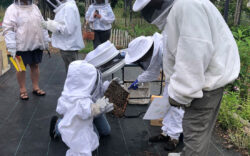If you hang out with gardeners for any significant amount of time, you’ll receive a bundle of advice and suggestions. Amateur or professional, plant people love their plants and want to pass on good information and compare notes. It’s a great motive, but wrong information can easily be repeated without a quick Google search to confirm accuracy. Since we’re at the beginning of “spooky season,” here’s a few of the gross and scary garden myths I’ve heard or believed myself:
Claim: This compost contains maggots and isn’t good to use.
Fact: But those maggots could be the good kind.
The first time I checked my compost bin and it was filled with squirming segmented bodies, I freaked. Maggots! Then I took a breath and a photo and sent it to my entomology-major friend. These little critters, she explained, were Black Fly Soldier larvae, and I was doing a bang-up job providing them an environment to break down my compost and eat other, nastier fly larvae. Black Fly Soldier larvae don’t eat plants or roots; they eat decomposing matter, as well as blowfly and housefly larvae. Black Fly Soldier larvae are such good composters (and so benign as adults) that some people prefer them over the much better known compost-creator, the red wiggler worm. Since then, I’ve heard stories of people finding maggots in their compost and picking them out. Instead, check online to identify exactly what you’ve got in your compost.
Claim: Pee on your strawberry plants for bigger, tastier fruit.
Fact: Probably true, but with tons of caveats.
I’m not advocating urinating on your plants. I don’t urinate on my plants. But I have had more than one experienced gardener tell me that peeing on my strawberry plants will produce bigger, tastier fruit. Urea is a chemical compound found in synthetic petroleum-based fertilizers and human urine. Urea’s chemical structure makes it easy for rain and soil microbes to break it down into available nitrogen for plants. So, if chemical companies are making a synthetic version of what human bodies produce, why not pee on your plants? Urine isn’t sterile. All the bacteria, viruses and pharmaceuticals in a body exit through urine. University of Michigan researchers released a study in 2020 about removing nearly all antibiotic-resistant bacteria by aging urine. Similar research focuses on removing pharmaceuticals and viruses with the ultimate aim of turning this waste stream into a safe, renewable (and cheap) source of fertilizer.
Claim: The Joro spider is a terrible invasive species that bites humans and kills hummingbirds.
Fact: Jury’s still out on how the Joro spider will affect northeast Georgia’s ecosystem, but it doesn’t seem dangerous to humans or birds.
Yes, the invasive, brightly colored giant spider with its golden webs is intimidating—but University of Georgia researchers say the spiders aren’t dangerous to humans. I admit, I have a personal bias when it comes to the Joros: I like them. Joros build webs above my head or in corners of the property I rarely walk. They eat invasive stink bugs and whiteflies by the handful. When I accidentally bump into a web, they run away instead of attacking. Joros don’t come inside. I wish all spiders living near me were so considerate. I’ve found black widows and Southern house spiders become especially aggressive in the fall while protecting their bulging egg sacs. I love my native spiny orb weaver spiders, but the same spider will build a web in my walking path multiple times a day. Joros just stay out of my way, and eat a bunch of pests.
According to some reports on social media, it appears that they can kill hummingbirds. Until a research-backed scientist says Joros are dangerous to hummingbirds, I remain skeptical. Hummingbirds (like all birds) have great eyesight. How could they not avoid a giant yellow web? University of Georgia researchers published a report in February detailing how well the Joro spider has adapted to life in Georgia and across the East Coast. I’m sure there will be plenty of studies in the years to come detailing the Joro spider’s effect on local ecosystems near and far.
Like what you just read? Support Flagpole by making a donation today. Every dollar you give helps fund our ongoing mission to provide Athens with quality, independent journalism.










